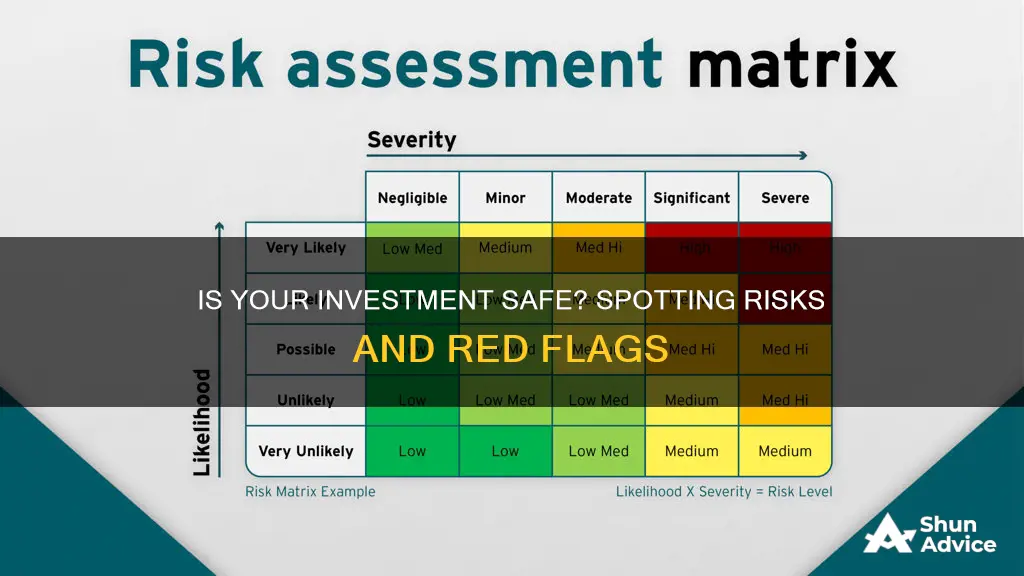
Knowing whether your investment is at risk is a fundamental part of financial planning. All investments carry some degree of risk, and it's important to understand the level of risk you are comfortable with and can afford to take on. Your risk tolerance depends on your age, life stage, goals, and financial circumstances. Generally, younger investors with a longer time horizon can afford to take on more risk, as they have more time to recover from potential losses. It's also important to consider your investment objectives, reliance on invested funds, and inherent personality traits when determining your risk tolerance. Diversifying your portfolio by investing in different asset classes and types of investments is a smart strategy to manage your risk exposure.
What You'll Learn

Evaluate your risk tolerance
Evaluating your risk tolerance is a fundamental step in planning your investment strategy. It is important to remember that there is no one-size-fits-all approach, and your risk tolerance will be unique to you. Here are some factors to consider when evaluating your risk tolerance:
Investment Objectives
The potential for significant growth often comes with a higher risk of substantial losses. If your objective is capital preservation or protecting your existing assets, you may opt for lower-risk investments, even if they may not result in the desired growth or income. Your investment objectives should be aligned with your needs, desired outcomes, and the risks you are willing to take to achieve your goals.
Investment Time Horizon
If you have a long-term investment horizon, such as planning for retirement early in your career, you can generally afford to take on more risk. With a longer time horizon, you have more time to recover from potential losses. On the other hand, if your timeline is short, you may want to avoid risking a significant decrease in your investment value just before you need to withdraw it.
Reliance Upon the Invested Funds
Consider whether you are relying on these funds to provide essential money for things like a down payment on a home or your child's education. If these funds are disposable income that won't significantly impact your lifestyle if lost, you may be more comfortable taking on risk. Evaluate your financial circumstances, including your earnings, net worth, and short-term and long-term spending requirements, to determine your reliance on the invested funds.
Inherent Personality
Your inherent personality traits can play a role in your risk tolerance. If you are generally a cautious person, you may be less comfortable with high-risk investments. While your risk tolerance should not outweigh logic in your investment decisions, it is important to consider your comfort level with risk. If the idea of losing money makes you uncomfortable, you may want to avoid the highest-risk investments to prevent early withdrawal due to volatility.
Liquidity Needs
Your liquidity or cash needs can impact your ability to take on risk. As the need for cash for a specific goal approaches, your risk tolerance typically decreases. Investing in stocks or bonds that could be at a low point when you need to sell may not be a wise choice.
Time Horizon
On the other hand, having a longer time horizon before needing the funds can increase your risk tolerance. With more time, you can better withstand stock market fluctuations and potentially recover from any losses.
Importance of the Goal
When the importance of the investment goal increases, your risk tolerance may decrease. For example, if you are funding long-term care or saving for your children's education, you may want to take a more conservative approach to lower the risk of not achieving these important goals.
Risk Capacity and Risk Willingness
Modern financial planning often utilises two independent risk scores: risk capacity and risk willingness. Risk capacity is based on your investment objectives, initial investment amount, and time horizon. It addresses your ability to handle risk. On the other hand, risk willingness indicates your comfort level with the volatility of investment returns and the probability of loss.
Age and Life Stage
Your age and life stage can also impact your risk tolerance. For example, if you are investing for retirement and are 45 years old, you have more time to grow your money and can generally take on more risk than someone who is 65 years old. With a longer time horizon, your investments have more time to ride out short-term fluctuations in the hope of achieving greater long-term returns.
Diversification
While diversification does not guarantee profit or protect against loss, it is a smart strategy to manage your risk exposure regardless of your risk tolerance. Diversifying your portfolio involves selecting investment products from different asset classes, such as stocks and bonds, and different types of investments within those asset classes.
Investment Management: Adding Value, Growing Client Wealth
You may want to see also

Understand your investment time horizon
Understanding your investment time horizon is crucial when assessing the risk of an investment. An investment time horizon refers to the period of time one expects to hold an investment before needing the money back. This is largely dictated by investment goals and strategies, and it can be broken down into three categories: short-term, medium-term, and long-term.
Short-term investment horizons refer to investments expected to last for fewer than five years. These are suitable for investors approaching retirement or who need a large sum of cash in the near future. Money market funds, savings accounts, certificates of deposit, and short-term bonds are good choices for short-term investments as they can easily be liquidated for cash.
Medium-term investment horizons are typically held for three to ten years, such as savings for a first home or marriage. Medium-term investment strategies tend to balance between high- and low-risk assets, so a mix of stocks and bonds is a good way to protect your wealth without losing value to inflation.
Long-term investment horizons are for investments held for ten or more years, with the most common example being retirement savings. Long-term investors are typically willing to take greater risks in exchange for greater rewards. The longer the time horizon, the more aggressive an investor can be in their portfolio.
The length of your investment horizon will determine the types of investments that are most suitable for your goals. Generally, the longer the time horizon, the more aggressive you can be in choosing your investments. For example, a long-term investment horizon of 10 years or more may allow you to invest in more aggressive and long-term investments such as stocks, mutual funds, and real estate. On the other hand, a short-term investment horizon means you cannot afford to take on a lot of risk, and preventing losses takes priority over accumulating wealth.
It's important to note that the risk you can handle is closely related to your investment horizon. The longer your investment horizon, the more time your investments have to recover from any losses. This allows you to take on more risk, as you have a greater capacity to withstand short-term fluctuations in the value of your investments.
Therefore, understanding your investment time horizon is crucial in determining the level of risk you are comfortable with and the types of investments that are suitable for your financial goals.
Lithium Investment Guide for Indians: Getting Started
You may want to see also

Assess your reliance on the invested funds
When assessing your reliance on the invested funds, it's important to consider how much you depend on this money to cover your essential expenses, both now and in the future. Ask yourself whether this investment is your main source of funding for important upcoming costs, such as a down payment on a home or your child's education. Alternatively, is this disposable income that won't significantly impact your lifestyle if you were to lose it?
The more reliant you are on these funds, the more cautious you should be with your investment strategy. If this money is essential for your immediate or future needs, you may want to opt for lower-risk investments that offer more stable returns. This is especially important if your investment timeline is short, as you won't want to risk a significant decrease in your account value just when you need to withdraw.
On the other hand, if this money is disposable income that you can afford to lose without affecting your essential expenses, you may feel more comfortable taking on higher-risk investments. These riskier investments come with the potential for significant growth but also carry a higher risk of substantial losses.
It's crucial to evaluate your financial circumstances and needs, including your short- and long-term spending requirements. Consider your routine expenses, such as housing, food, transportation, and utilities, as well as emergency or periodic expenses like medical care or car repairs. By understanding how reliant you are on the invested funds, you can make more informed investment decisions that align with your financial goals and risk tolerance.
A Guide to Investing in Ripple Currency in India
You may want to see also

Consider the liquidity of your investments
Liquidity risk is one of the key risks to be aware of when assessing the risk level of your investments. Liquidity refers to how quickly an investment can be converted to cash. It is important to consider the liquidity of your investments in tandem with when you expect to need the funds.
If you are investing for the long term, you can probably afford to take on more risk, as you have more time to ride out short-term fluctuations and losses. For example, if you are in your 20s and planning for retirement, you have decades to make up for any losses your account might sustain. In this case, you could consider investing in higher-risk assets such as stocks or growth stocks, which have the potential for significant growth but also come with a higher risk of significant losses.
On the other hand, if you have a short investment time horizon and expect to need the funds soon, you likely don't want to risk your account value seeing a significant decrease just before you withdraw. In this case, you may want to consider investing in more liquid assets, such as cash or cash equivalents, which are less risky and can be easily converted to cash. However, it is important to note that investing solely in cash investments may carry inflation risk, which is the risk that inflation will outpace and erode returns over time.
Another factor to consider is your risk tolerance, or how comfortable you are with taking on investment risk. If you are risk-averse, you may prefer to invest in more liquid assets, even if it means sacrificing potential gains. Conversely, if you are a risk-seeker, you may be willing to invest in less liquid assets with higher potential returns.
Finally, consider your financial circumstances and how reliant you are on the invested funds. If this is money that you can afford to lose or that won't impact your lifestyle if you take losses, you may be more comfortable taking on illiquid investments. However, if you are counting on this money to provide essential funds, you may want to prioritize liquidity to ensure that you can access the funds when needed.
Crafting a Personal Investment Plan: Strategies for Success
You may want to see also

Diversify your investments
Diversifying your investments is a crucial aspect of managing your financial risk. Here are some detailed insights and guidelines on diversifying your investments:
Understanding Diversification
Diversification is a fundamental investment strategy centred on the idea of "not putting all your eggs in one basket." By spreading your investments across various assets, sectors, or markets, you reduce the potential impact of losses. While diversification doesn't guarantee profit or eliminate risk entirely, it improves your chances of maintaining or minimising losses during market downturns.
Key Considerations for Diversification
- Time Horizon: Consider your investment timeline. If you have a long-term goal, such as retirement, you may be more willing to take on additional risk by investing in more volatile assets. Conversely, if your goal is short-term, you may lean towards more conservative investments to preserve your principal.
- Risk Tolerance: Evaluate your comfort level with risk. Consider your financial situation, including liabilities and cash assets. If you have a higher risk tolerance, you may invest more aggressively, while a lower risk tolerance may lead you towards more conservative investments.
- Asset Allocation: Diversification involves allocating your investments across different asset classes. This can include stocks, bonds, cash, mutual funds, exchange-traded funds (ETFs), real estate investment trusts (REITs), and commodities.
- Correlation of Investments: When diversifying, look for assets with low or negative correlations. This means that if one investment declines, the other tends to move in the opposite direction, helping to balance your portfolio.
- Number of Investments: Keep your portfolio manageable. While diversification is essential, investing in too many vehicles can be challenging to manage. Aim for a balanced number of investments, such as 20 to 30 different options.
- Regular Review: Remember that your investment strategy should evolve with your circumstances. Regularly review and rebalance your portfolio to ensure it aligns with your changing time horizon, risk tolerance, and financial goals.
Practical Tips for Diversification
- Spread the Wealth: Diversify across different companies, sectors, and asset classes. Consider investing in a range of companies you know and trust, including those you use in your daily life.
- Index and Bond Funds: Include index funds or fixed-income funds in your portfolio. These funds track broad market indexes and can provide long-term diversification while hedging against market volatility.
- Dollar-Cost Averaging: This strategy involves investing a fixed amount regularly, helping to smooth out market volatility. By investing the same amount over time, you buy more shares when prices are low and fewer when prices are high.
- Stay Informed: Stay current with your investments and overall market conditions. Knowing what's happening in the market and with the companies you invest in will help you make timely decisions about buying, holding, or selling.
- Be Mindful of Fees: Understand the fees associated with your investments. Some firms charge monthly fees, while others have transactional fees. Evaluate whether the fees align with the services and potential returns you're getting.
Oil Giants Eye India's Gas Production Potential
You may want to see also
Frequently asked questions
Your risk tolerance is the amount of investment risk you’re willing and able to accept. This is impacted by factors such as your investment objectives, time horizon, reliance on the funds, and personality.
The higher the risk of a particular investment, the higher the possible return. However, there is always a risk of losing some or all of your money.
Some common types of investment risks include market risk, inflation risk, interest rate risk, reinvestment rate risk, default risk, liquidity risk, political risk, and currency risk.
Diversifying your investments across different asset classes and types of investments can help to protect your portfolio. Additionally, consider factors such as your time horizon, bankroll, and risk tolerance when making investment decisions.







